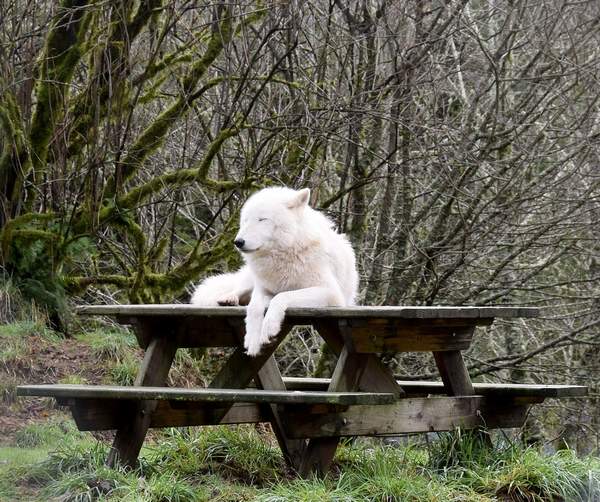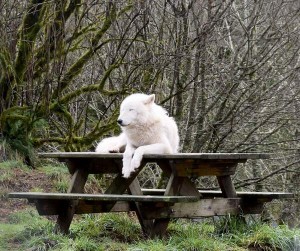For the TODAY
I’ve conducted interviews in the rain, on a train, even while in pain. But when interviewing Lois Tulleners at her 50-acre White Wolf Sanctuary, my attempts to maintain an air of professionalism came to a screeching halt when the wolves started to howl.
“Why?” I squeaked out, awed by the sound of 12 wolves howling at once.
“It could be anything,” Lois answered, “Because you’re new, a deer’s nearby, or a hawk, or they just felt like it. I rarely know why they start, but still love the sound and the way they all start and quit together; it’s like they have a conductor.”
I was just glad I had my voice recorder on; it is truly a stirring sound for someone who lives where wolves no longer roam.
Lois found her life’s purpose by accident, when a boyfriend who is now long gone expressed the desire to get a few wolves.
“I told him ‘I don’t think so,’” she said, “But he brought two home anyway. That’s how I got interested in the breed. When they passed away I worked in a zoo and later at other sanctuaries.”
Then, 25 years ago, she purchased the Tidewater property that now houses Artic wolves, and occasionally other subspecies like tundra and timber wolves.
“The wolves here were all born in captive situations.” Lois said, meaning small cages, or in many cases, at the end of a chain. “Once they come here they’re here to stay.”
As I drove up the winding road to the sanctuary, I have to admit to some trepidation about seeing wolves in confinement, but once I entered the grounds that fear was dispelled.
“It’s hard for us to get good photos because the fences make people think the wolves are in cages,” Lois said. “When I worked at the zoo and other sanctuaries it always hurt me that the wild animals couldn’t run so when I built this place, it was extremely important to me that they would have lots of room. We’re also set up so that we can move them around a lot. In zoos they call it enrichment; we just call it moving the wolves. Even as big as their space here is, the wolves use it all.”
The large spaces also let the wolves express their true nature.
“They still hunt little varmints like moles,” Lois said.
As the tour progressed, I found myself unable to tell which buildings were for humans and which for wolves.
“We call this the wolf church,” Lois said to describe a particularly comely cabin. “When I first bought this property there was nothing on it but grass and that little cabin which was in bad shape. Some wonderful gentlemen from the golf course in Waldport volunteered to help me restore it, and their wives brought the stained glass window, a star of David and a Buddha, so we call it the wolf church. Although they aren’t all this fancy, all the enclosures have houses in them to keep the wolves out of the rain.”
At first staring warily, a few of the wolves warmed up to me enough to let me approach the fence.
“They’re usually shy,” Lois said. “They’re liking you though.”
Liking me meant I got a few kisses through the fence, but as much as I wanted to feel special, it’s not that rare an occurrence.
“We had a little boy here once and one of the wolves was kissing him,” Lois said. “He turned to his mom and said, ‘Mom, I just got my first French kiss,’ and the mom said, ‘I’m so glad it was from a wolf.’”
But although some of the wolves at the sanctuary love getting scratched or giving kisses, Lois stresses that they are not pets.
“We always keep in mind that these are wild animals, and we don’t breed, sell, rent, trade or lease them,” she said. “This is a true sanctuary. But we know them all, and they know their names.” Current residents include Goliath, who is 11, and his girlfriend Hope, who is 16 and is blind and partially deaf.
“In the wild, Arctic [wolves] usually live four or five years, in the lower 48, timber wolves usually make it to six or seven” Lois said. “Most of the ones I’ve lost here have been 15. I’m amazed Hope has made it to 16. She kind of bosses Goliath around a bit, but we should all have a man like him; he is so good to her. When we move them, Goliath always brings her favorite blanket to the new enclosure.”
Oregon has removed wolves from the endangered list, which has invigorated Lois in her mission.
“Education is such a big part of what we do,” she said. “Wolves are being shot and poisoned by people who just don’t realize how important they are to our environment. Yellowstone is a perfect example of why we need wolves; before they reintroduced them everything in the park was out of balance. The reintroduction is restoring it; even the rivers are affected. We only have about 88 wolves in Oregon and we need to do what we can to protect them.”
Source: Oregon Coast Today

